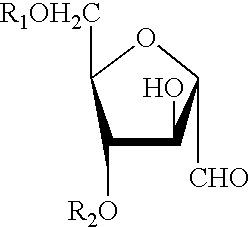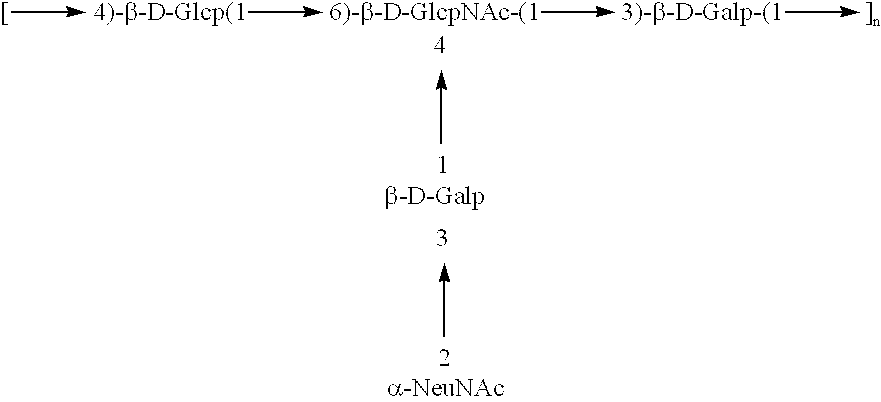Method of immunization using a Group B Streptococcus type II and type III polysaccharide conjugate vaccine
a polysaccharide conjugate and vaccine technology, applied in the direction of antibacterial agents, carrier-bound antigen/hapten ingredients, antibacterial medical ingredients, etc., can solve the problems of poor immunogenic response of infants and young children to polysaccharide antigens, and poor efficiency of coupleing to proteins
- Summary
- Abstract
- Description
- Claims
- Application Information
AI Technical Summary
Problems solved by technology
Method used
Image
Examples
example 1
Base Depolymerization and Sodium Nitrite Mediated Ring Contraction To Produce GBS Type II And III 2,5-anhydro-D-Mannose Terminated Fragments
GBS Type II
Native type II GBS CP (75 mg) of average molecular weight about 200,000 was dissolved in 3 ml of 0.5 N NaOH and the solution was then divided in 3 parts (1 ml each). The samples (S1-S3) were heated at 70.degree. C. for 60, 90 and 180 min respectively, then chilled in an ice-water bath. 125 mcL of glacial acetic acid was added to each sample to bring their pH to 4. Following addition of 200 mcL of 5% (w / v) NaNO.sub.2 the samples were kept under stirring at 4.degree. C. for 2 hrs. S1-S3 samples were then diluted to 5 ml with DI water and their pH adjusted to 7 with 0.5 N NaOH. Excess reagents were dialysed out by diafiltration with DI water through a DIAFLO ultrafiltration membrane (Amicon YM 10) and the solutions were lyophilized. Three type II polysaccharide fragments (II-1-II-3) were obtained.
GBS Type III
Native type III GES PCP (125 ...
example 2
Conjugation of the Type II and Type III Polysaccharide Haptens to Tetanus Toxoid
Tetanus toxoid (SSI, Denmark) was first purified to its monomeric form by gel filtration through a BIOGEL-A column (Biorad Laboratories). The tetanus toxoid monomer (TTm) thus obtained (150,000 Daltons) was solubilized in 0.2 M phosphate buffer, pH 7.5, at a concentration of 25 mg / ml and added to dried GBS type II (II-1 to II-3) or type III (III-1 to III-5) polysaccharides and recrystallized sodium cyanoborohydride NaCNBH.sub.3 in the amounts shown below:
The reaction mixtures were then incubated at 37.degree. C. for 4 days. The progress of the conjugation reaction was monitored by HPLC of small aliquots of the reaction mixtures analyzed on SUPEROSE-12 (Pharmacia). The conjugates were purified by molecular exclusion chromatography on a column of SUPERDEX G-200 (Pharmacia) using PBS containing 0.01% thimerosal as an eluant. Fractions eluting from the column were monitored by a Waters R403 differential refr...
example 3
Immunogenic Response of Female Mice To Immunization With GBS Type II and Type III-Tetanus Toxoid Conjugate Vaccines
a. Immunizations
Groups of 10 Swiss Webster female mice (4-6 weeks old) were immunized subcutaneously with 2 .mu.g of either native type II or III polysaccharide or their corresponding Tetanus-toxoid conjugates. The vaccine were absorbed on aluminum hydroxide (ALHYDROGEL; Superfos, Denmark) at a concentration of 1 mg of elemental aluminum / mi of 10 mM PBS containing 0.01% thimerosal. Mice received the vaccine at days 0, 21 and 42 and finally were exsanguinated at day 52. Sera were collected and stored at 70.degree. C.
b. ELISAs and Opsonic Activity of Conjugate Antisera
ELISAs: Microtiter plates (Nunc Polysorb ELISA plates) were sensitized by adding 100 .mu.L of native type II or III polysaccharide-HSA conjugate (1 .mu.g / ml) in PBS with 0.02% azide per well. The plates were incubated at 37.degree. C. for one hour. The plates were washed with PBS containing 0.5% TWEEN 20 (PB...
PUM
| Property | Measurement | Unit |
|---|---|---|
| average molecular weights | aaaaa | aaaaa |
| average molecular weights | aaaaa | aaaaa |
| average molecular weights | aaaaa | aaaaa |
Abstract
Description
Claims
Application Information
 Login to View More
Login to View More - R&D
- Intellectual Property
- Life Sciences
- Materials
- Tech Scout
- Unparalleled Data Quality
- Higher Quality Content
- 60% Fewer Hallucinations
Browse by: Latest US Patents, China's latest patents, Technical Efficacy Thesaurus, Application Domain, Technology Topic, Popular Technical Reports.
© 2025 PatSnap. All rights reserved.Legal|Privacy policy|Modern Slavery Act Transparency Statement|Sitemap|About US| Contact US: help@patsnap.com



